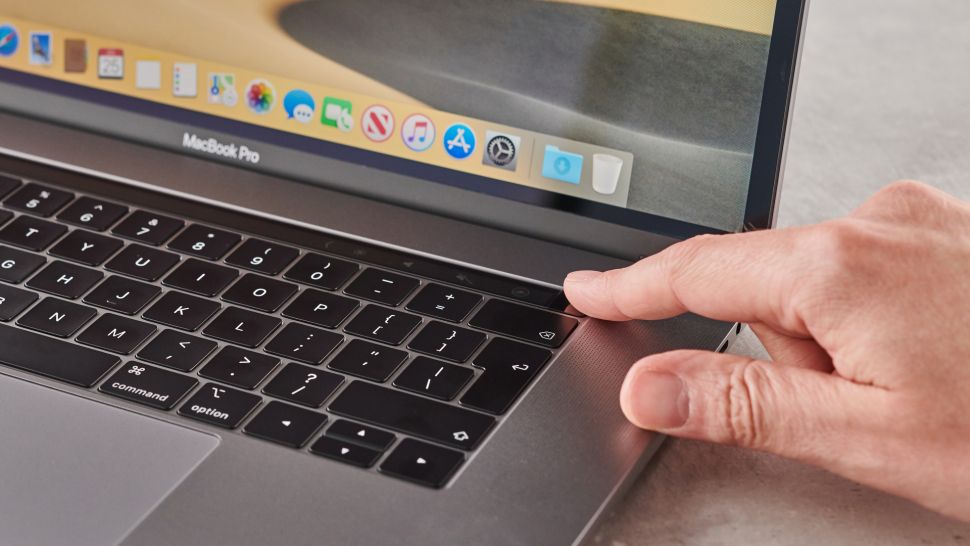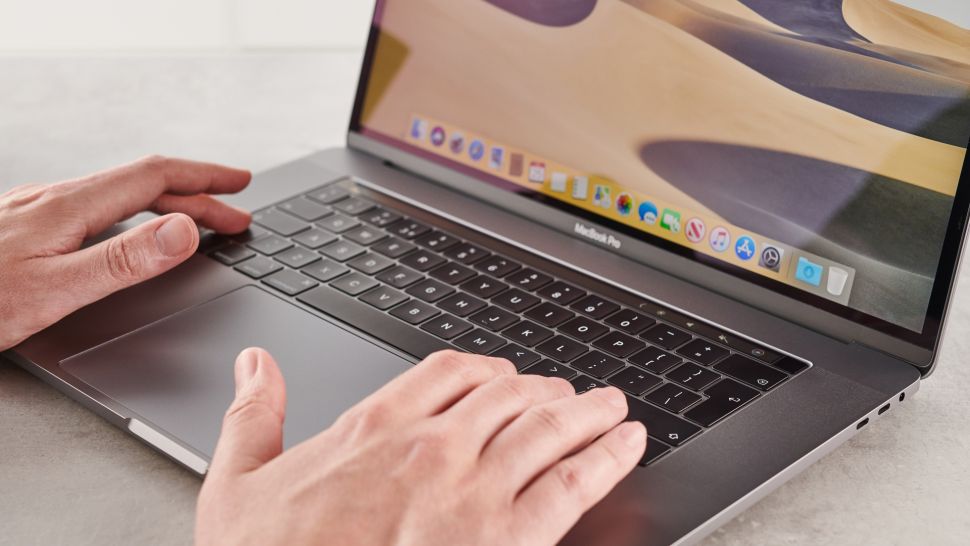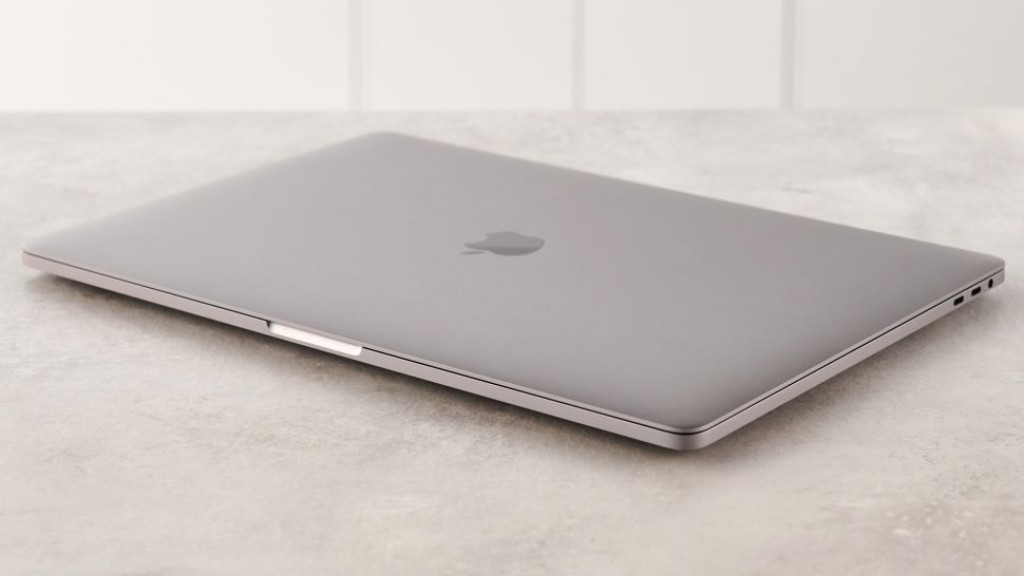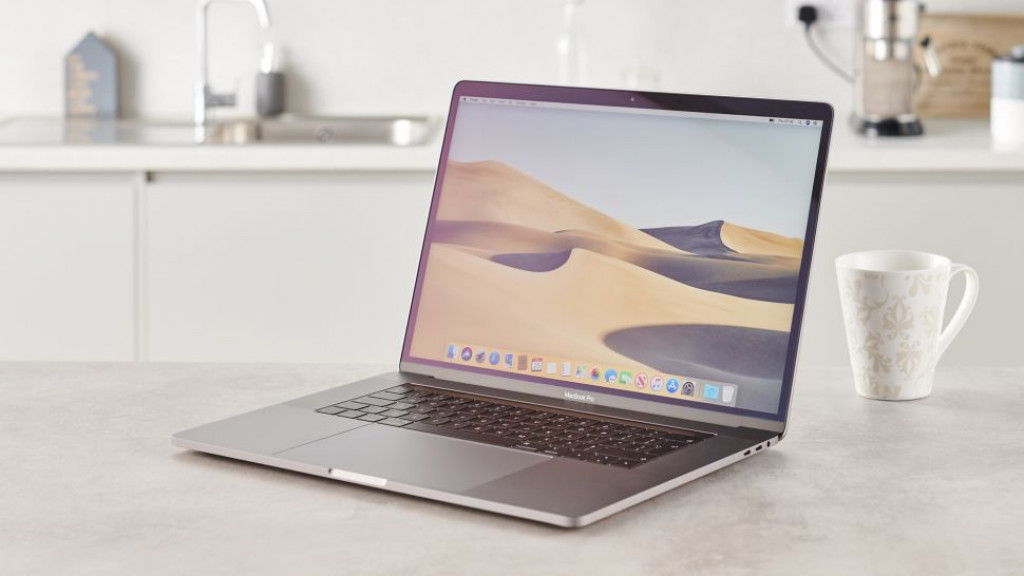
OUR VERDICT
Once again, with the MacBook Pro 2019 refreshes, Apple has built a well-designed professional laptop with the MacBook Pro 15-inch (2019). Its upgraded internal components bring a welcome boost. However, the lack of port variety stops it from being a truly flexible prosumer device.
FOR
- Powerful
- Decent configuration options
- Screen remains gorgeous
AGAINST
- Expensive
- Lack of ports
- Keyboard concerns remain
In retrospect, Apple not giving the MacBook Pro (15-inch, 2019) a massive redesign would have made more sense had we known that the manufacturer was planning on phasing it out to make way for MacBook Pro (16-inch, 2019). However, at the time of our testing, the MacBook Pro (15-inch, 2019) just felt like an iteration of the previous year’s model, perhaps necessary only to folks who haven’t upgraded their already aging laptop in years.
Not that the MacBook Pro (15-inch, 2019) doesn’t have its share of fresh features you won’t find in older models. After putting it through the paces, we’ve come to realize that it’s got a few aces up its sleeves: a much improved keyboard, for one. And, specs-wise, the highest configuration of the line now boasts some incremental changes, more than enough to make it worth the upgrade if you’ve got a 2017 or older MacBook.
Apple needed a win, with all those excellent Windows laptops upping the ante in the Ultrabook category, and the MacBook Pro (15-inch, 2019) certainly helped with that. Sure, it doesn’t get a massive redesign – not in the way that the new MacBook Pro (16-inch, 2019) got – but it’s fantastic enough to lure Windows users over to macOS.

Price and availability
The MacBook Pro 15-inch (2019) is available in two main configurations (which you can further customize to better suit your needs and budget). First, there’s an option with a 2.6GHz 6-core 9th generation Intel Core i7 processor, Radeon Pro 555X with 4GB of GDDR5 memory, 16GB 2400MHz DDR4 RAM and 256GB SSD storage for $2,399 (£2,399, AU$3,499/AED9,999).
Then, there’s a model equipped with a 2.3GHz 8-core 9th generation Intel Core i9 processor, Radeon Pro 560X with 4GB of GDDR5 memory, 16GB DDR4 memory and 512GB SSD storage for $2,799 (£2,799, AU$4,099/AED11,679).
In the US and Australia, this price compares favorably with last year’s base model, which sold for $2,399 (£2,349, AU$3,499) and came with a 2.2GHz, 6-core 8th generation Intel Core i7 CPU, Radeon Pro 555X GPU, 16GB of DDR4 memory and a 256GB SSD. That’s basically the same spec, aside from the updated processor and GPU.
While the US and Australia essentially get an upgrade for free, UK readers will have noticed a price increase. This is due to Apple bringing UK prices into line with US dollars, so for Apple, £1 = $1. Now, for anyone with even a passing familiarity of exchange rates, you’ll know that this is a fairly raw deal for the UK. However, keep in mind that the US price doesn’t include tax, whereas the UK price does.
As we stated earlier, all the MacBook 2019 models can be configured to add more powerful components if you want – and can afford – them.
In fact, the model Apple sent us to review is something you’d have to configure yourself. It’s the highest-end model, so it comes equipped with an 8th generation Intel Core i9 processor with 8 cores and a 2.4GHz clock speed (5.0Ghz boost), 32GB RAM, AMD Radeon Pro Vega 20 with 4GB of HBM2 memory and 4TB of SSD storage for $5,149 (£4,914, AU$7,859, AED21,549).
This means if you want to buy the model we’ve tested here, then you’re going to need to spend a lot of money. Still, at least there are lower-priced options, and the base MacBook Pro 15-inch (2019) compares favorably with the Razer Blade Pro 17 (2019), one of the latest Windows laptops trying to win professionals away from Apple. That sets you back $2,499.99 (£2,399.99, AU$4,299) for the base model with a 6-core 9th generation Intel processor and Nvidia GeForce RTX 2060 graphics card.
Comparing the two, we’d give the edge to the MacBook Pro 15-inch (2019) as a pure productivity device, taking into consideration the specs, build quality and (slightly) lower price.

Design
If you’ve ever seen or used a MacBook Pro, then you already know what the MacBook Pro 15-inch (2019) looks like. The last time the series got a considerable design change was back in 2016 with the addition of the Touch Bar, and the 2019 model looks – at least on the outside – pretty much the same as the previous models.
This is great news for anyone who believes that the MacBook Pro aesthetic is pretty much on point. On the other hand, it will disappoint anyone who is looking for a fresh new look.
So, the MacBook Pro 15-inch (2019)’s dimensions are 13.7 x 9.48 x 0.61-inches (34.92 x 24.07 x 1.55), basically the same as last year’s model, and is slightly smaller than MacBook Pros launched before 2016’s refresh. The new MacBook Pro 15 also weighs 4.02 pounds (1.83kg) – which, again, is exactly the same as last year’s model.
Color-wise, you’re again restricted to the choice of merely two – Space Gray and Silver. Port-wise, you’ll have four Thunderbolt 3/USB-C ports (two on each side of the laptop) as well as an audio jack port – a rarity on an Apple device these days.

While some people will appreciate the minimalism of only having four Thunderbolt ports – which are fast and versatile (as they are compatible with many connection types and can also double as charging ports) – for many other people, the lack of variety in ports is an irritation, especially on a product that’s meant at professionals.
Anyone who relies on older peripherals like mice, keyboards or external hard drives will need to invest in an adapter. This can lead to a cluttered look, and it’s an additional cost – as Apple doesn’t include an adapter. That’s somewhat disappointing, especially when you’re already spending so much money on a laptop, and many of its competitors now include an adapter – take Acer’s new Swift 7, for example.
Now, one of the explanations for the lack of ports is so that Apple can keep the thin design of the MacBook 2019 line. We’d counter that first of all, if you’re looking for a productivity machine, you want something that lets you work with the tools you depend on with minimum fuss. That’s more important than having an outrageously thin laptop.
Secondly, the Razer Blade Pro 17 (2019) showcases how to have a slim laptop (its dimensions are 15.55 x 10.24 x 0.78-inches, which isn’t a lot larger than the MacBook Pro, especially considering it has a 17-inch display) and still have all the essential ports. It has an Ethernet, two USB 3.2, two USB-C 3.2, a 3.5mm audio jack, HDMI 2.0B and an SD card reader. That’s the kind of port selection that many people – particularly photographers – would find extremely useful and convenient.
It’s also worth keeping in mind that whenever you’re charging the MacBook Pro or any MacBook 2019, one of those valuable Thunderbolt ports is unavailable, basically cutting the number of ports down to three.

As with previous MacBook Pros (and other Apple devices), there is also no way to open up the MacBook Pro 15-inch (2019) and fix or upgrade its parts without voiding the warranty. While many people are ok with that, it does mean that you’re at the mercy of Apple (and Apple approved vendors) if something goes wrong. And, you can forget about adding more RAM or a bigger hard drive to extend the life of your expensive purchase.
Going back to the Razer Blade Pro 17 (2019) for a moment, that machine allows for comparatively effortless upgrading of RAM and storage, with an additional storage slot for another SSD if you need it. While many people may not make use of this, it still makes it a more tempting prospect for professionals who want to get the most future-proof laptop they can.
The 15.4-inch screen is inherited from last year’s – which is not a bad thing as the Retina display remains stunning-looking with a 2,880 x 1,800 resolution. There’s also support for the DCI-P3 color space, which is critical for video editors. The True Tone feature, which makes colors on the screen look more vibrant and realistic (although, it’s at the expense of accuracy) is also included – and this can be switched on or off depending on your preferences (and needs).
Generally, however, the design of the line of MacBook 2019 model refreshes offer nothing new. If you love the look of the MacBook, this will be music to your ears.

Keyboard
Since the introduction of the 2016 MacBook Pros, which brought the ‘butterfly’ switch mechanism to the laptops’ keyboards, there have been quite a few complaints about the keyboards malfunctioning, particularly if debris (like crumbs or dust) end up between the keys.
Last year, in an attempt to fix the issue, Apple installed a silicone membrane to block debris from causing havoc. However, it didn’t really work. News that some keyboards were flawed justifiably bothered anyone investing a considerable sum in Apple’s newest laptops.
On the upside, the MacBook 2019 models of the Pro have once again received improvements. While the keyboard still uses the butterfly switches, Apple said that it has switched the materials used with the mechanism to lessen the probability of the keys getting stuck or becoming unresponsive when pressed, the two main problems previous keyboards had.
Apple hasn’t been too transparent on the particular details of the changes it has made to the keyboard. During our tests, we didn’t experience any issues. However, we didn’t with previous models either.
While the change is welcome, it’s still too bad that Apple hasn’t radically altered the design of the keyboard to guarantee that those issues never occur again. The fact that it includes the new MacBook 2019 models, the Pro included, in its Keyboard Service Program, which will replace a faulty keyboard free of charge, sort of implies that Apple hasn’t completely fixed the issue. Hopefully, any issues with the MacBook Pro 15-inch (2019)’s keyboards will prove infrequent.
The keyboard itself doesn’t feel significantly different to use – perhaps somewhat softer to type on than non-membrane keyboards, but it’s mostly business as usual. So, nice large keys that are easy to hit and comfortable to type on.
They’re also backlit for using in dimly-lit environments, and there’s the Touch Bar, a thin glass touchscreen that stretches along the top of the keyboard, displaying context-sensitive buttons on its 2,170 x 60 resolution screen. These buttons change depending on the application or task that you’re performing, created to give you fast shortcuts for a more seamless workflow.
You’ve possibly made up your mind about how valuable (or not) the Touch Bar is if you’ve used earlier MacBook Pros. We quite like it, and since its unveiling in the 2016 model, more apps are taking advantage.

Next to the Touch Bar sits a fingerprint scanner for quickly and securely logging in to the computer as well as authorizing payments. It’s quick and easy to set up, and accurately reads your fingerprint and logs you in without fuss – something that many fingerprint readers on laptops fail to do.
The touchpad also remains unchanged – large, responsive and does its job well, if you want to skip the use an external mouse.
In all, we cautiously welcome the updates Apple has made to the keyboard – and time will tell if they are enough to thwart any more problems. However, we wish Apple did more to eliminate any such doubts – though that would undoubtedly involve a major overhaul of the keyboard.
Such an overhaul is actually rumored for a 16-inch MacBook Pro that could launch later this year.
As you’d imagine with a brand-new MacBook Pro with the kind of specs we were sent, the MacBook Pro 15-inch (2019) runs smoothly, with macOS 10.14 feeling fast and responsive when doing daily tasks.
Of course, you’d be doing a laptop of this level a disservice if you only use it for run-of-the-mill stuff like web browsing and writing emails. Even with the more challenging and intensive workloads we’ve tried it with – such as transcoding high definition video files – the MacBook Pro 15-inch (2019) handles them without breaking a sweat.
Just like last year’s model, we noticed that the MacBook Pro 15-inch (2019) does get pretty toasty during particular tasks – and you can feel that heat behind the keys as you type. The MacBook Pro’s fans are also prone to kicking in, and while you can hear them whirring away, they aren’t too disrupting.

When it comes to the raw stats of our benchmark results, you can tell how much of an upgrade this year’s high-end version is over last year’s.
In the Cinebench CPU benchmark, the MacBook Pro 15-inch (2019) scores 3,142 – a large bump over the 2018’s 1,057. The Geekbench 4 processor benchmark shows another big leap over last year’s model, with a single core score of 5,829 (vs 5,542) and a multi-core score of 30,478 (vs 23,431).
Therefore, in the processor department, the new MacBook Pro 15-inch (2019) is undeniably an upgrade. Graphics also get a boost, with the high-end AMD Radeon Pro Vega 20 with 4GB of HBM2 in the 2019 model scoring 129.63 FPS in the Cinebench benchmark, next to the 102.28 fps that the 2018 model’s AMD Radeon Pro 560X delivered.
But, there are also some things you should keep in mind regarding these benchmark results. First, synthetic benchmark results are a good gauge of the raw power of a device, but they don’t precisely tell the whole story.

Our time with the MacBook Pro 15-inch (2019) left us in no doubt that this is a very powerful laptop, but then so is the 2018 model. Honestly, if you own last year’s model and are happy with its performance, don’t dump it for this model just because of marginally higher numbers.
Another important thing to keep in mind about these benchmark results is that these numbers are for the maxed-out MacBook Pro 15-inch (2019) Apple sent us. Unless you have the money to shell out and require that kind of power, you won’t be using the exact same MacBook 2019 iteration of the Pro as us. If you want these results, then prepare to spend a lot for it.
Battery life
With the more powerful internals fitted in this year’s model, the battery life seems to have taken a bit of a hit, with the laptop lasting only 7 hours and 36 minutes during our battery tests that involves looping a 1080p video at 50% brightness and volume.
That’s still about the length of a full workday, and you may manage to squeeze out a bit more juice by toggling some settings and turning off unnecessary features. However, you’ll be wise to carry around the MacBook Pro’s charger just in case you do run out of battery.
If you’re performing more intensive tasks – such video rendering – then you’ll definitely want to plug the laptop in.
Apple claims the MacBook Pro 15-inch (2019) can handle 10 hours of wireless internet browsing, which seems to be its default claim for MacBook Pros these days. While we didn’t see the battery last quite that long during our tests, it still lasts longer than some of its Windows-based rivals, particularly the Razer Blade Pro, which has embarrassingly low battery life – though that’s probably due to its origins as a gaming laptop.
Where the MacBook Pro 15-inch (2019) shines at compared to Windows laptops – as with earlier models – is how long it lasts on standby, with Apple claiming up to 30 days of standby time. This means you can shut the lid of the MacBook Pro 15-inch (2019) without fully turning it back off, and even after a few days, when you open it back up, there will still be battery to work with.
We found this to be the case, although we didn’t get an opportunity to test the full 30-day claim. It’s a commendable feat especially seeing that a Windows laptop, when closed, still drains its battery ridiculously fast.

Verdict
So, is the MacBook Pro 15-inch (2019) worth paying for to upgrade from the 2018 model? Definitely not, but then no one should expect that.
Still, if you do have an aging MacBook Pro – especially one that came before the 2016 refresh – then you should consider upgrading to this year’s model. Admittedly, it’s only a minor upgrade in the grand scheme of things, but it still makes it the most powerful MacBook 2019 has to offer.
The addition of Intel’s latest 8-core processors does make a big difference to the performance of the MacBook Pro 15-inch (2019). If you’re considering buying one, we recommend this option, not only for the boost in performance, but also future-proofing as well, as you won’t feel the need to upgrade for a substantial amount of time.
However, if you already own a more recent MacBook Pro, don’t feel like you’re missing out if you don’t get this version. The spec bumps just aren’t drastic enough to make your current MacBook Pro archaic.
Source: techradar.com









































